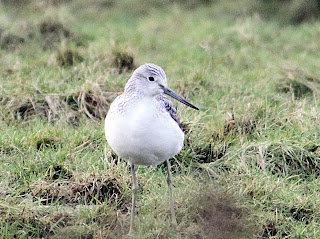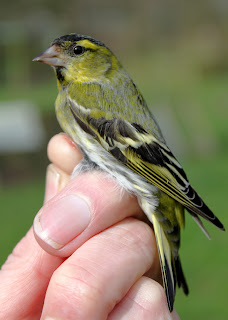It was a bright blue sky this morning after clear overnight and when I looked across the estuary from Knott End and out towards the Wyre Light all was calm serenity save for the hoot of the 8am ferry. All right I exaggerated the blue a little but not the flat water as the east wind was barely perceptible, leaving the river like a mirror.

I struggled to find many birds, even the 2 drake Eider hidden at the base of the jetty half way to Fleetwood so far was the tide out. A couple each of Linnets, Goldfinch, Meadow Pipits and "albas" flew from up river but I couldn’t be certain if they were migrants or not. Apart from the actual beautiful morning, the weather conditions hadn’t been ideal for migrants again so I headed for Pilling and my favourite walk in search of the mythical, elusive Wheatear.
At Lane Ends I saw my first “mallard” ducklings of the year, seven multi coloured bundles of fluff scooting across the pool with mum when a dog got too close to the water’s edge. Also on the pools were 2 pairs of Tufted Duck, the Little Grebes and a drake Gadwall, no sign of the female from last week! What I took to be the same Kestrel from Wednesday hung around but didn’t perform for me as it did the day before. Just as well I took plenty of pictures, because I didn’t today apart from a Chaffinch and a Woodpigeon – well someone has to. In the plantation I didn’t see or hear a single Willow Warbler or Chiffchaff, only the still present Reed Buntings represented the little brown jobs.




Towards Pilling Water I had the usual smattering of Meadow Pipits and Skylarks, now only 800 Pink-footed Geese, 4 Little Egrets and on the wildfowler’s pools, 90 Redshank. Apologies but it’s yet another Little Egret picture.
I was sat at the stile at Pilling Water when I received a message that IG had seen a Marsh Harrier over his Fleetwood house; so I looked both west towards the river then north towards Heysham and south over Pilling itself, but couldn’t pick up on anything that big heading my way. Sometimes I think the harriers on hitting the coast at Fleetwood follow the course of the Wyre up river and thence across to the mosslands. That’s my excuse for not refinding this one but I did have a single Whimbrel again, the highlight of my sea wall vigil.
Wheatears? None! But better luck tomorrow I hope with a ringing session elsewhere.




































































